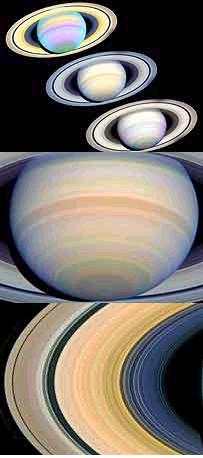Saturn, the king of the rings, was photographed a few months ago from the Hubble Space Telescope in three artificial colors, when the planet was inclined at 26 degrees towards the Earth and the rings were at maximum key.
Avi Blizovsky

Saturn was photographed in ultraviolet light, visible light and infrared light at various stages of its 29.5-year orbit around the Sun. Its inclination angle relative to its orbit is relatively high and therefore it appears to swing to and from the Sun, similar to the Earth.
This means that every 30 years or so astronomers get their best look at the South Pole and the entire southern part of the rings. The last time this happened was in March and April 2003, and the researchers took advantage of it to take the best pictures ever.
Layers and colors
In Hubble's wide-field planetary camera #2, thirty filters are used that span a wide range of bandwidths, from the ultraviolet, through visible light, to the infrared region of the spectrum. "The series of thirty filters enabled the most in-depth spectral analysis of Saturn" said Eric Karkoschka from the University of Arizona.
"They can do this because particles in the planet's atmosphere reflect different wavelengths of light in different ways, causing some gases to appear in the image and others to disappear.
By studying the nebulae and clouds visible in these multispectral images, researchers can learn about the dynamics of Saturn's atmosphere, and the composition of the gases in Saturn's clouds.
For example, small aerosols are only visible in ultraviolet light because they do not scatter or absorb visible light or infrared light, which has a higher wavelength.
In some of the frequencies in the visible range and in the infrared range, the absorption of light by the methane gas blocks all but the uppermost layers of the atmosphere, and this helps researchers locate the structure of clouds in the different layers of the atmosphere.
